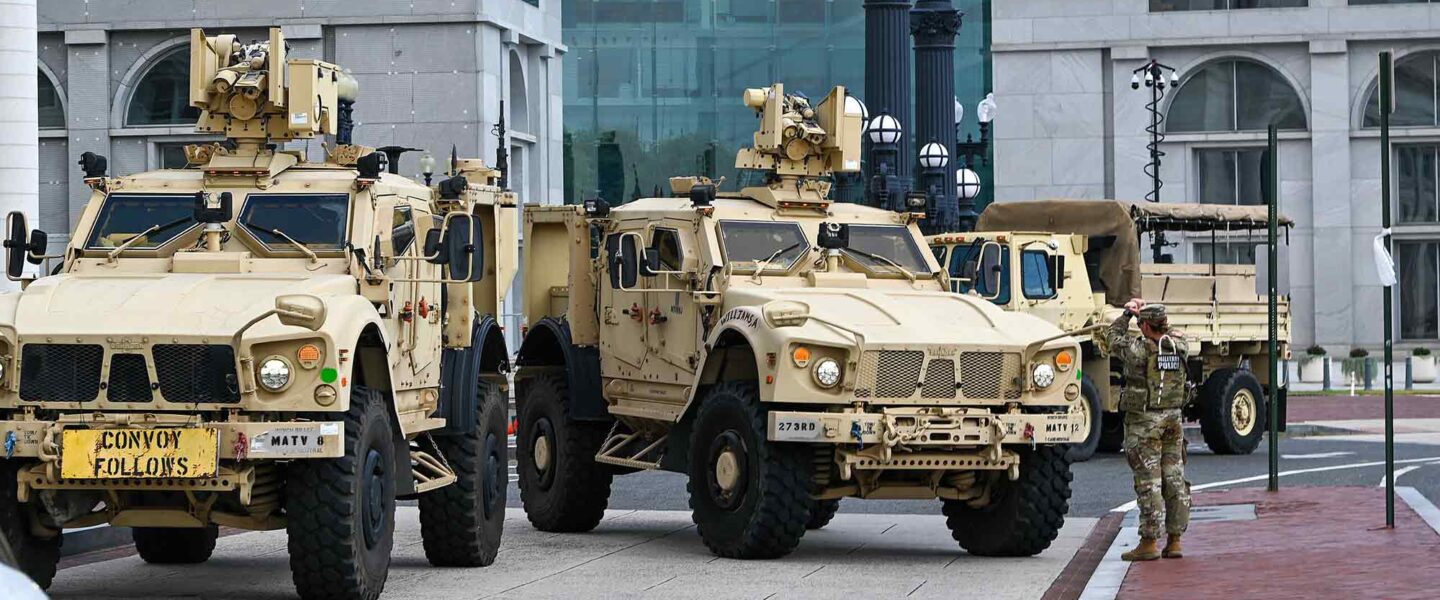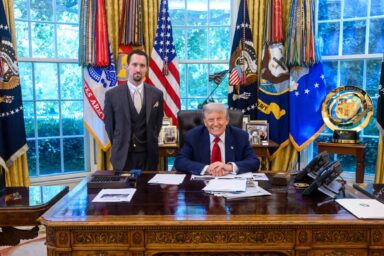Donald Trump is declaring imaginary emergencies to amass more and more power. Occupying Washington, DC, is just the latest example.
|
Listen To This Story
|
When Donald Trump was asked this week about the 30-day limit that applies to his order to take over the Washington, DC Metropolitan Police Department (MPD), and whether he would seek the required congressional approval to extend it, he noted that he does not have to do so “if it’s a national emergency.”
The president added that he would not want to do so, and that he expected the GOP-led Congress to do his bidding (like it nearly always does), but by that time he already had declared an emergency. It is the basis for the executive order that invoked the Home Rule Act and put the MPD under federal control.
Now, even if you disregard the statistics that show violent crime declining sharply in the nation’s capital, and instead choose to believe that it is rampant because you heard about some dude named “Big Balls” getting beat up (and because all those tough guy, alpha male GOP lawmakers keep telling Fox News how scared they are to set foot outside of their homes), crime in Washington hardly constitutes a “national emergency.”
Trump, who routinely ignores facts in favor of fiction, simply declares in his order that “crime is out of control in the District of Columbia.”
And, just like that, an emergency is created.
It’s not the only one facing the United States, at least not according to the president.
On his first day in office, he declared a national emergency at the US-Mexico border to allow the Pentagon to deploy troops to assist the Department of Homeland Security in securing it.
Trump also declared a “national energy emergency” and one regarding trade, which allowed him to willy-nilly impose tariffs on other countries. Specific “national emergencies” target Canada and China (for not stopping drugs from flowing into the US), and Brazil for prosecuting one of the president’s allies.
You may not be aware of this, but there are currently 48 “national emergencies” in effect.
Most of these involve sanctions of some form or another, for example, on certain governments or individuals (the oldest active one, declared by Jimmy Carter in 1979, freezes Iranian assets).
Most of them are (or were) prompted by real emergencies, for example, the one related to the coronavirus pandemic, and these “normal” emergencies are typically ended once the respective crisis is deemed to be over.
So, what is Trump doing that’s so different and so dangerous?
Simple. National emergencies grant the government powers it ordinarily doesn’t have — like deploying troops domestically.
Trump is declaring these “emergencies” at a much higher rate than any other president, and most of the actions his emergencies mandate are much more substantive than imposing sanctions on international bad actors.
In the first seven months of Trump’s second term, there have been nine of these declarations, which matches all the national emergencies Joe Biden declared in his four years in office.
In addition, Trump is invoking obscure laws that are seldom (if ever) used to grant himself extraordinary powers, such as the Alien Enemies Act of 1798, which allows presidents to deport individuals in a time of war and is being used by the administration to justify sending undocumented migrants to foreign prisons without due process.
Or, as in the case of Washington, DC, the Home Rule Act of 1973.
In addition, Trump has openly mused about invoking the Insurrection Act of 1807, which allows the use of active-duty troops to perform law enforcement duties.
You are no doubt seeing a common thread.
Trump loves deploying the military to do his bidding. He sent troops to the southern border with Mexico, to Los Angeles to quell a nonexistent “insurrection” there after protests erupted following arbitrary ICE raids that have since been ruled illegal, and to DC, which already looked as though it were under military occupation, even before West Virginia’s governor announced Saturday that he would send a few hundred additional guardsmen to the nation’s capital to address the imaginary crisis there.
And that brings us to the actual national emergency that is happening in Washington, DC, right now: an out-of-control president who is following the autocratic blueprint of dictators of the past.
Invoking (and sometimes conjuring) emergencies is a tried and tested method that allows authoritarian rulers to amass power — and the president is currently doing so at a troubling rate by simply overpowering the institutions that are supposed to stop somebody like him.
Trump has overwhelmed fact checkers, the media, the justice system, reasonable people in the GOP, and Democrats who are haplessly trying to counter him with an outdated political playbook written for an era when opponents across the aisle contended for power without dictatorial ambitions.
We, like many others, predicted this would happen in Trump’s second term, but even pessimistic experts are surprised and alarmed by the speed with which he is remaking the country.
Hardly a day goes by without his administration doing stuff that is, at best, legally questionable, which is a charitable description of actions that are often blatantly unconstitutional.
But pointing that out is like telling thieves that robbing banks is wrong. They already know, but they also know that’s where the money is. Trump and his henchmen (male and female) know where the levers of power are — and they want them all in Trump’s hands.
He is also aided and abetted by supposedly co-equal branches of government that have abdicated the rights and responsibilities that kept presidents in check for nearly 250 years. Although it should be noted that many lower court judges are trying to do their jobs, it takes them time to rule on complicated issues even when it’s clear that the president is acting in bad faith. And when they do rule against a presidential power grab, they are often overruled by higher courts, on up to the Supreme Court).
However, it’s not just Congress and the Supreme Court.
One respected institution after another is either buckling under Trumpian pressure (like academia), failing to sound the alarm (like the media), or complicit in an unseemly rush to secure profits (like corporate America).
Finally, there are the American people, who have not yet woken up to how dire the situation is.
Too many Americans still have a mindset that “This can’t happen here.”
Well, it is happening, right now, and the citizens of our tottering democracy are the only ones who can put a stop to this authoritarian takeover.
We will talk about what must be done now and how to do it in the second part of this editorial.
If you don’t want to miss it, sign up for one of our daily or weekly newsletters, subscribe to our substack, or follow us on BlueSky.




